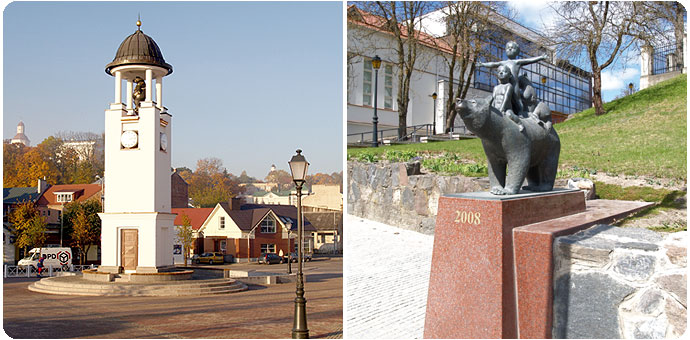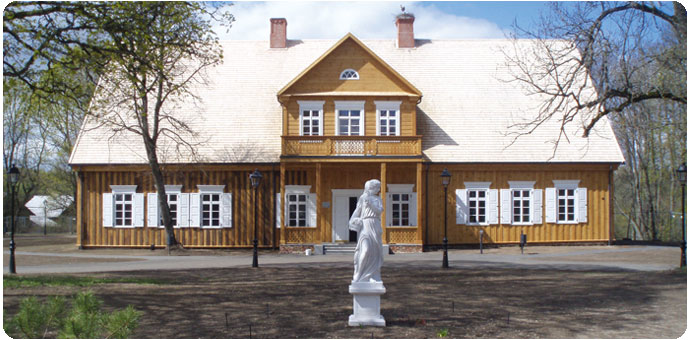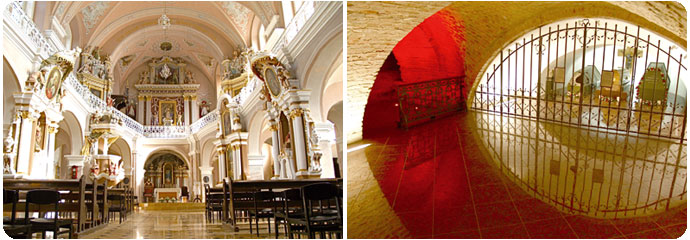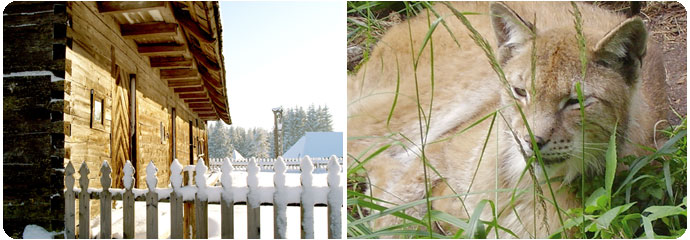
|
Laikrodžio bokštas.
Nuotr. autorius A. Žebrauskas |
Skulptūra „Žemaitijos
legendos“.
Nuotr. autorius A. Žebrauskas |
Telšiai is the capital of Samogitia established on seven hills
and easterly and westerly surrounding Mastis Lake waved by the legends. The name for the
city was given by small Telšė stream flowing to Mastis. Telšiai in historical sources
are mentioned since 1450. In the end of XVIII century the city was provided with
Magdeburgas rights and soon Telšiai become cultural and politic centre of Samogitians.
Beautiful old-town of Telšiai is announced as urban monument.
Beautiful church of late baroque-classicism stands on the highest hill of the city. It was
built in the end of XVIII century (since 1926 it is called Telšiai cathedral). Bishopric
residence is established in Telšiai and also theological seminary functions there. It is
possible to familiarize with Telšiai land history in Samogitian museum “Alka”. Telšiai
district attracts with its nature, old mounds, auk hills, mysterious lakes, cultural,
culinary and historical heritage, and active cultural life. There a lot of festivals,
holidays and other events functions.

|
| Biržuvėnų dvaras. Nuotr. autorė E. Macienė. |
|
VISITING PLACES
• SAMOGITIAN MUSEUM “ALKA“
Muziejaus str. 31, Telšiai. Tel. +370 444 70282
The museum is of regional studies character. It accumulates ethnographic, archaeological
collections, folk application and descriptive art works, historical collections, heritage
of estate’s culture, large scientific archive.
• SAMOGITIA VILLAGE MUSEUM. Malūno str. 5, Telšiai
Tel. +370 444 70266, +370 444 70001, mob. +370 688 42566
In the authentic Samogitia village buildings located in the area of 7.5 hectares and
existed in the end of XIX century and in the beginning of XX century a lot of that time
domestic thing, economy implement, and furniture are exhibited.
• A. JONUŠAS SAMOGITIAN-JAPANESE-CHINESE HOMESTEAD-MUSEUM
Muziejaus str. 88, Telšiai. Mob. +370 674 19308
This is an island of the orient sun – Samogitian-Japanese-Chinese homestead-museum
created by the hands of an artist jeweler A. Jonušas.
• TELŠIAI ST. ANTANAS PADUVIETIS CATHEDRAL. Katedros avenue 2, Telšiai
Built in 1765. It is of late baroque and classicism style. The church includes 7 altars. 2
of them are central. The central altar of second floor is committed for one of the supreme
Franciscan saint – St. Antanas which is considered to be miraculous by the believers. In
2009 the underground of the Cathedral included restored vaulting, bishop’s burring
crypt, laid new floor, installed lightening, sound system and installed new entrance from
the inside of the Cathedral. The Cathedral includes set new anniversary gates committed
for the mention of 600 year christening and having artistically represented christening
history of Samogitia. Also the gates of Cathedral churchyard were reconstructed too.
• TELŠIAI ORTHODOX ST. NICOLAUS CHURCH
Žalgirio str. 8, Telšiai. Tel. +370 444 51578
This is the one of the most beautiful examples of cubism architecture in Lithuania.
In the church you will see oaken handmade iconic altar created in the middle of XIX
century.
• TELŠIAI YESHIVA. Iždinės str. 11, Telšiai
Telšiai yeshiva as higher school of rabbinate was established in 1873.
In XIX century it was accredited one of the largest in the world where already practiced
rabbinate from all over the world had improved their knowledge.
• CHURCH OF TAKING HOLY MARY INTO THE HEAVEN
Šviesos str. 2, Telšiai
Established in 1536 by the king Žygimantas I. Old wooden parish church was burned and
rebuild several times. Currently in the church you can see old pictures, 3 beautiful
altars.
• THE FIRST SCHOOL OF TELŠIAI CITY
Kalno str. 1/Katedros venue 3, Telšiai
The school was built in 1795-1798 at the small square before the church and monastery.
Polish and Jewish languages were lectured in the school. Later the school was expanded to
6 classes and legally equated with the gymnasium. Students of this school had active
performed in the rebellion of 1831 year so tsarist administration had closed the school in
1832. During the year of Lithuania Independence it was primary-school. Here various
schools had founded till 1944.
• SUFFERING CHAPEL
Rainiai, Viešvėnai dist., Telšiai r. Tel. +370 444 70282
In the beginning of the World War II from former Telšiai prison during the night between
24th and 25th of June of 1941 Bolsheviks had brought 76 politic prisoners to Rainiai
forest and cruelly killed. In 1991 for the memory of them Suffering chapel was built
inside which the museum committed for the memory of Rainiai sufferers functions.
 |
Telšių šv. Antano Paduviečio katedra.
Nuotr. autorius A. Žebrauskas |
Katedros požemiai.
Nuotr. autorius A. Žebrauskas |
• ŽVĖRINČIUS
Laukstėnai village, Degaičiai dist., Telšiai r. Mob. +370 686 33137
Žvėrinčius was established in 1996 in Ubiškės Woodward place in order to familiarize
the society with the life of wild animals. Žvėrinčius includes turkeys, lynxes, wolves,
moufflons, fallow-deers, bear Timas, boar Jadzė and boar offsprings. For the convenience
of the visitors in order to observe the life of wild animals two survey sites, a bower,
visual sites, playground for children are installed. Also the oak is set including
nesting-boxes and the stand with the descriptions of most common in Lithuania animals and
birds.
• OSTRICH SELECTION CENTRE
Brizgai village, Telšiai r. Tel./fax +370 46 314659. Mob. +370 682 25501
Ostrich economy of Jonas Molnikas is one of the largest in Samogitia. It gets into 5 of
the largest economies in Lithuania. It includes built farm, incubators, and installed
enclosure for the ostriches. Visiting allowed only after the agreement in advance.
• J. ANDRIUSEVIČIUS MUSEUM IN GAULĖNAI
Gaulėnai village, Upyna dist., Telšiai r. Mob. +370 682 49806
This is a museum of regional studies character established in Gaulėnai primary-school.
There archaeological material is exhibited starting from the earliest times (Neolithic
age) and historical material of Šatrija, Gaulėnai, Maudžiorai, Luokė surroundings
mentioning later times.
• VIEKŠNALIAI REGIONAL STUDIES MUSEUM
Viekšnaliai village, Luokė dist., Telšiai r. Tel. +370 444 67735
Over 1000 exhibits of village domestic life were accumulated from surrounding villages.
They are showed in 4 rooms. In 2001 the museum was supplemented by new exhibits by
Lithuanian J. Kojelis living in USA. The corner is appointed for his honor. The museum is
appointed in Viekšnaliai primary-school.
• PAVIRVYTIS ESTATE. Tryškiai, Telšiai r. Mob. +370 692 89388
This is wooden estate of the beginning of XVIII century once belonged to the grandees’
Šemetos. The estate includes accumulated large collection of art that was saved during
the World War I but it was exported in 1940 by Russian soldiers in the unknown direction.
Two big oaks grow at the estate. The size of one of them is 6.20 m, another – 5.60 m.
• BIRŽUVĖNAI ESTATE. Biržuvėnai village, Luokė dist., Telšiai r.
Today Biržuvėnai – valuable example of large wooden estate homestead of XVIII–XIX
century, is reflecting natural process of such homesteads in feudalism period.
Master house of Biržuvėnai estate was rebuilt in 2011 m. The authentic of reconstructed
house was tried to be saved. The house is decorated with the furniture of antique style.
Here we can see authentic remained fireplaces with the tiles of XVIII century, chimney,
and floor bricks. Also the penthouse is installed where mostly had included residential
rooms. The visitors can see the accommodations of drawing-rooms, kitchen, and master’s
bedroom, cabinet and other. Near the master’s house servant’s house, stable and place
for carriages are being rebuilt.
• DŽIUGINĖNAI ESTATE
Džiuginėnai village, Gadūnavas distr., Telšiai r. Tel. +370 444 70282
The estate is composed of 4 buildings. The life of this estate is related with the family
of the landed gentry Gorskiai famous in Samogitia, writer Žemaitė, researcher of
Samogitia art and the artist and photograph J. Perkovskis.
• BRĖVIKIAI ESTATE
Brėvikiai village, Gadūnavo dist., Telšiai r. Mob. +370 698 28852 (estate can be
observed only after the agreement in advance).
From the oldest times the estate had belong to an old family of Samogitian noblemen
Narutavičiai. Till nowadays wooden residential house (palace), barn, residues of the
cellar, part of an old avenue of the estate had remained. Now Stanislovas Narutavičius
museum is started to be prepared.
• SAMOGITIAN KING RINGAUDAS ESTATE IN A.GEDVILAS HOMESTEAD
Ryškėnai, Telšiai r. Tel. +370 444 70614
While building the estate A.Gedvilas had the purpose not only to unleash concentrated
creative forces but also to pay attention to the history of old times Samogitia.
• SAMOGITIAN BISHOPRIC MUSEUM
S.Daukanto str. 6, Varniai, Telšiai r. Tel./fax. +370 444 47455, mob. +370 687 20198.
e-mail ai@varniai-museum.lt,
http://www.varniai-museum.lt
Samogitian bishopric museum was established in 1999 in the building of late baroque, in
the former palace of Varniai Samogitian theological seminary built in 1770 by the endeavor
of Bishop Jonas Dominykas Lopacinskis.
• VARNIAI CATHEDRAL – ST. PETER AND PAUL CHURCH
M. Valančiaus str. 4, Varniai, Telšiai r. Tel./fax +370 444 47455
This building was founded by the most famous representative of second half of XVII century
of the Great Duchy of Lithuania, Samogitian Bishop Kazimieras Pacas. The cathedral is the
example of mature Lithuanian baroque architecture. In includes a lot of monuments of
interior art: 12 altars, portrait gallery of Samogitian bishops, the great altar of
Konigsberg master and the states, magnificent and unique organ of XIX century. Varniai
Cathedral is a particular pantheon because its Bishop’s crypt includes 10 Samogitian
bishops.
 |
| Žemaitijos kaimo muziejus. Nuotr. aut.
T. Lekavičius |
Žvėrinčius |
• VARNIAI REGIONAL PARK
Ožtakiai village, Varniai dist, Telšiai r. Tel./fax +370 444 47415, mob.: +370 686
13153, +370 614 80893
E-mail. varniu-rp@takas.lt, http://www.varniuparkas.lt
The park is established in 1992 in order to save the landscape of Samogitian central laky
mountain range, its natural ecosystem and valuables of cultural heritage.
• COGNITIVE PATH OF JOMANTAI FOREST
Jomantai forest, Viešvėnų dist., Telšiai r.
The main purpose of the path of Jomantai forest is cognitive: to deliver the possibility
to familiarize with the forest, here existing nature monuments, forest residents, forest
benefit for the person, forester specialty work, farming in the forest and old traditions.
• DEBESNAI BOTANICAL PATH
Graužai village, Varniai dist., Telšiai r.
The main purpose of Debesnai botanical path is to familiarize the visitors of the path
with unique variety of lower swamp vegetation, dominant species and their communities. You
will find the path in the valley of Varnelė River at its source from Lūkstas Lake near
Varniai city.
• ILGIS LAKE COGNITIVE PATH
Džiuginėnai forest, Ryškėnai dist., Telšiai r.
The main purpose of the path is to familiarize the society with the vegetation of the
forest and apply it for active leisure. This is loved resort by Telšiai residents in the
reserve of Germantas landscape at Ilgis Lake. In 2005 there were cognitive path around
Ilgis Lake appointed. There the path pebbled with the boards through onshore of the lake
was appointed and survey site on the poles over the water was appointed too.
• PANŲ HILL. Pasruojės village, Gadūnavas dist., Telšiai r.
In the forest at the main road Telšiai-Seda approximately at 10th kilometer a cross is
standing showing the path which will guide to the depth of the forest and fids Panų hill,
also called Mergakalnis.
Panų hill is a hill famous of stories, overgrow with pines, surrounded by swamps.
Nowadays high Mass is sacrificed in Panų hill. The prayers attend the hill, assemble
crosses and daggers round the chapel.
• SPRŪDĖ HILL. Šaukštelio village, Varniai dist., Telšiai r.
The territory of Sprūdė mound includes 26 hectares of land. Here defensive ditches and
residues of the banks up to four meters had remained. Down Sprūdė mound the views to
Varniai pool overlook – the lakes Biržulis and Lūkstas, also Varniai, Luokė, Šatrija,
Girgždūtė, Medvėgalis mounds are very visible.
In 2011 Sprūdė hill was adapted to tourists visiting: approach to the mound, parking
place for the cars, wooden steps, informational stand, survey site were appointed. Survey
site includes two boulders-stands with the references to surrounding objects seen from Sprūdė.
The system of the paths had been formatted in order the visitors could familiarize with
the most beautiful views, outstanding terraces, and ritual poles.
• ŠATRIJA HILL. Pašatrija village, Luokė dist., Telšiai r.
Šatrija is one of the most famous archaeological monuments not only in Samogitia but also
in all Lithuania. The surroundings of the hill are announced as reserve of Šatrija
landscape having area of 813 hectares. The height above sea level of Šatrija hill is 228
m.
According to archaeologist wooden castle used to be standing on the top of the hill and
people used to be living already since II century before Christ. Supposedly, one of the
most important belief centers of Lithuanians was there that was destroyed after the
introduction of Samogitia Christianity.
Wide and clear down land can be seen down from Šatrija. Medvėgalis overlooking km is
visible over 35, somewhere around exists other giants of Samogitia: Girgždūtė,
Moteraitis, and Sprūdė. Also we can see Luokė, Viekšnaliai, Upyna, Gaulėnai, Užventis,
towers of Telšiai cathedral.
• THE SCULPTURE “FOOTMARK OF THE BEAR“. Turgaus avenue, Telšiai
The sculptor – Osvaldas Neniškis, architect – Prof. Algirdas Žebrauskas.
After putting the hand into imprinted claw you can be sure that you will be strong and
forceful as a bear. This is a claw of fabulous totem of Samogitia – the bear of
Samogitia, denotative the place of land capital.
• THE SCULPTURE “THE GLOBE OF SAMOGITIA“. Turgaus avenue 17, Telšiai
The author – student Artūras Valiūnas, manager of the work – artist Romualdas Inčirauskas,
architect – Prof. Algirdas Žebrauskas.
It was built in 2008. The idea of author’s cultural object – intellectual answer to
those who are thinking that there are no Samogitians. The globe includes represented
countries of Samogitia corresponding real map and that Telšiai, as Rome, is standing on
seven hills.
• THE SCULPTURE “LEGENDS OF SAMOGITIA“. Respublikos str., Telšiai
The author/sculptor – Romualdas Kvintas, architects – Prof. Algirdas Žebrauskas. In
2008 the monument was built. The monument represents the bear carrying teddy bears and
junior Samogitians on its back — the Mother of Samogitia. The sculpture reminds the
legends alive in the folk about the bears that had helped Samogitians to grow and educate
their children. There after gently scrubbing the nose of the bear you can expect the
verification of good wishes.
|






